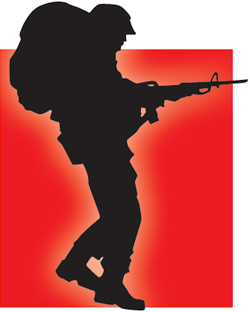INDIAN ARMED FORCES CHIEFS ON OUR RELENTLESS AND FOCUSED PUBLISHING EFFORTS

The insightful articles, inspiring narrations and analytical perspectives presented by the Editorial Team, establish an alluring connect with the reader. My compliments and best wishes to SP Guide Publications.

"Over the past 60 years, the growth of SP Guide Publications has mirrored the rising stature of Indian Navy. Its well-researched and informative magazines on Defence and Aerospace sector have served to shape an educated opinion of our military personnel, policy makers and the public alike. I wish SP's Publication team continued success, fair winds and following seas in all future endeavour!"

Since, its inception in 1964, SP Guide Publications has consistently demonstrated commitment to high-quality journalism in the aerospace and defence sectors, earning a well-deserved reputation as Asia's largest media house in this domain. I wish SP Guide Publications continued success in its pursuit of excellence.
- Appointments Committee of Cabinet approves one-month extension in service of Chief of the Army Staff
- Admiral Dinesh K. Tripathi assumes Command of the Indian Navy as 26th Chief of the Naval Staff
- Prime Minister witnesses 'Bharat Shakti' – a Tri-Services Firing and Manoeuvre Exercise in Pokhran, Rajasthan
- Interim Defence Budget 2024-25 — An Analysis
- Union Defence budget 2024
- Prime Minister Modi Commemorates Indian Navy Day in a Grand Ceremony
National Security Strategy Priority for new government

While threats are mostly identifiable, vulnerabilities may not be clearly identifiable as latter are only indicators. Challenge of implementing NSS lies in preventing vulnerabilities transforming into threats using non-military elements of national power.
India is all set for a new government which by all indications will be a stronger one considering the party around which the government is to be formed would have far larger base than in the earlier two governments elected in 2004 and 2009. This provides India the opportunity to undergo the much required strategic transformation, setting in motion the country’s aspiration to attain its rightful place in the comity of nations.
A priority task for the new government would be to define a National Security Strategy (NSS) followed by a Strategic Defence Review (SDR), latter ironically glossed over by the Naresh Chandra Committee. It is not surprising that former Ambassador G. Parthasarathy (himself a member of the Committee) has gone on record to say that the conduct of the Naresh Chandra Committee left much to be desired. The foremost need is to enunciate the NSS to shape the environment in India’s favour. In doing so, organizations and entities like the Ministry of Defence, Ministry of Home Affairs, Military, Economic Ministries, Department of Science & Technology, Department of Atomic Energy, Indian Space Research Organisation, etc need to be closely integrated.
Threats and vulnerabilities need to be taken into account. While threats are mostly identifiable, vulnerabilities may not be clearly identifiable as latter are only indicators. Challenge of implementing NSS lies in preventing vulnerabilities transforming into threats using non-military elements of national power. The NSS should include the following: one, India’s political aims goals in terms of power projection, promoting security, economic, technology, environmental and biodiversity interests; two, India’s interests in other countries and regions extending outwards from South Asia; three, interests and relationship matrix with major powers and the UN; and four, threats, challenges and competitors to India’s interests in respect of the above paradigms.
Like NSS of any country, there would also be a need to include the following that may remain undeclared: first, strategy to deal with competition and challenges by setting time bound objectives in diplomatic, economic, technology, and defence and security fields vis-à-vis the competitors; second, identify economic, strategic, military and technology leverages—inter-se priorities of countries; third, lay down strategic choices for entering strategic partnership in the short- mid- and long-term context; fourth, review of internal dynamics of India, its linkages with trans-border threats and challenges posed for the security forces including assessing degree of expected involvement of armed forces in the internal dynamics.
As mentioned earlier, the SDR must immediately follow up from the NSS though work on both can progress simultaneously. The SDR should state present military strategy as derived from the NSS and project into the future or we would indeed always be fighting yesterday’s wars. In this context, the NSS could be broadly relevant up to next 15 years and the thinking into period beyond that may be termed as vision. The SDR should comprise: analysis of the present military strategy and the changed goals; related emerging technologies and consequent revolution in military affairs (RMA); mesh future conflict spectrum and the battle space milieu; compare above with roles and individual responsibilities of the Army, Navy and Air Force, leading to development of joint force capabilities including for network-centric warfare (NCW).
Future military perspective (short- mid- and longterm) or joint military vision and military missions so developed would lead to formulation of Long Term Integrated Perspective Plan based on integrated systems dynamics and force development imperatives. The undeclared portion of the SDR should include: adversaries or countries that are in security competition, cooperation and friends; comparative evaluation of the nature of threats or competition; threat from competing strategic and security alliances; goals and objectives of bilateral, multilateral and international defence cooperation; policy on role of armed forces in asymmetric threats and internal conflict; strategy for protection of critical infrastructure from cyber threats; defence related aspects of cyberspace, space and perception warfare, and; strategy for energy, water and food security. Axiomatically, appropriate core groups would need to be established working out the NSS and SDR.
Simultaneous to the NSS and SDR, work should also commence to holistically review comprehensive national security, to include: personal security; community security; food security; health security; military security; economic security; energy security, political security, and; environment security.





